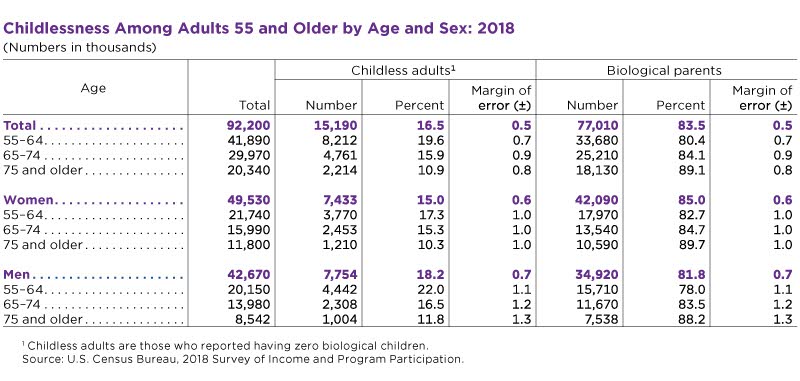Childless Older Adults More Educated, More Likely to Live Alone Than Older Parents
As the United States ages and the youngest baby boomers are now 58, the remarkable changes American families have gone through in recent decades highlight a new phenomenon: older adults without children.
Declines in marriage and fertility and increased cohabitation in the general population are starting to be reflected in the lives of aging adults.
Of the 92.2 million adults ages 55 and older in 2018, 15.2 million (16.5%) are childless, defined here as having no biological children.
Whether by choice or circumstance, many older adults do not have children. A new Census Bureau report, Childless Older Americans: 2018, provides much-needed information on these older adults and their wellbeing.
How Many Older Adults Are Childless?
Of the 92.2 million adults ages 55 and older in 2018, 15.2 million (16.5%) are childless, defined here as having no biological children.
Moreover, childlessness is more common among the younger cohort of older adults. This suggests that childless adults will make up an even greater share of the older adult population in the future.
How do Childless Older Adults Compare to Older Parents?
Childless adults have higher levels of personal net worth and educational attainment than older parents of biological children. They also are less likely to have a disability.
However, childless older adults are also more likely than parents to receive financial support from friends or family and more likely to be in poverty.
This suggests that the childless older adult population is multifaceted, with a portion who are socioeconomically well-off and another who may be at greater risk of financial hardship.
Other differences emerge when we analyze older childless women and men separately:
- Childless women have higher median personal net worth ($173,800) than childless men ($132,500).
- Childless women are also more likely to consider themselves in good health (77%), compared to 72% of childless men.
Who Supports Older Childless Adults?
While we do not have direct measures of caregiving, we use the detailed relationship information collected for all household members to identify potential sources of support within their household.
Childless older adults have fewer sources of potential support within their households: about 4 in 10 childless older adults live alone, compared to 2 in 10 parents.
Childless adults are also less likely to have gotten married and, therefore, less likely to be living with a spouse than are parents.
About 40% of childless adults are living with a spouse, compared to 63% of parents.
They are more likely than parents to be living with a cohabiting partner, but these relationships are still relatively uncommon among older adults: only 5% of childless adults and 3% of parents are cohabiting.
About 13% of older parents and 12% of older childless adults live with another type of relative such as an aunt/uncle, cousin, nephew, or parent.
It is important to remember that although childless adults have fewer sources of potential support within their households, those with more resources may be in a better position to obtain paid care than parents.
These data come from the 2018 Survey of Income and Program Participation (SIPP). The SIPP is a nationally representative longitudinal survey administered by the U.S. Census Bureau that provides comprehensive information on the dynamics of income, employment, household composition, and government program participation.
Because the SIPP provides detailed socioeconomic and relationship information about household members, along with well-being indicators and complete fertility histories of men and women, this report provides a holistic view of this growing population.
More information about SIPP data quality is available on the SIPP website's Technical Documentation page.
Note: This research was supported in part by the National Institute on Aging.
Tayelor Valerio is a survey statistician and Rose M. Kreider is a branch chief in the Census Bureau’s Social, Economic, and Housing Statistics Division.
Wan He is director of the Aging Research Program in the Census Bureau’s Population Division.
Related Statistics
-
Stats for StoriesOlder Americans Month: May 2023The 2021 American Community Survey estimated there were 55,892,014 people aged 65 and over in the U.S. out of a total population of 331,893,745, or 16.8%.
-
Stats for StoriesNational Senior Citizens Day: August 21, 2023According to the U.S. Census Bureau, there were 55.8M U.S. residents 65 years and older in the 2020 Census and 57.8M in the July 1, 2022, population estimates.
-
Stats for StoriesUnmarried and Single Americans Week: September 17-23, 2023In 2022, about 132.3 million or 49.3% of Americans age 15 and over were unmarried, according to the Current Population Survey.
-
Facts for Features & Special Editions*Special Edition* 1950 Census Records ReleaseIn this Special Edition FFF, we compare notable 1950 Census facts with the 2020 Census or other U.S. Census Bureau surveys and programs.
-
Facts for Features & Special EditionsAnniversary of Americans With Disabilities Act: July 26, 2021July 26, 1990: President George H. W. Bush signed into law the American with Disabilities Act, which prohibits discrimination against people with disabilities.
Subscribe
Our email newsletter is sent out on the day we publish a story. Get an alert directly in your inbox to read, share and blog about our newest stories.
Contact our Public Information Office for media inquiries or interviews.
-
America Counts StoryWhat Happens When Older Adults Struggle to Make Ends Meet?October 28, 2021The packages of needs-based assistance that some older adults rely on may indicate difficulty affording health care, food, shelter and other necessities.
-
America Counts StoryThe Graying of America: More Older Adults Than Kids by 2035March 13, 2018The middle-aged in the United States already outnumber children but the nation is headed for a new demographic milestone as it becomes older than ever before.
-
America Counts StoryWorking-Age Population Not Keeping Pace With Growth in Older AmericansJune 25, 2020Population estimates released by the Census Bureau today show a shift in the size of the working-age population relative to older and younger Americans.
-
America Counts StoryLove and Loss Among Older AdultsApril 22, 2021Nine in 10 adults ages 70 or older have married, but over half of women and a quarter of men ages 75 or older who have been married have experienced widowhood.
-
America Counts StoryA Long Life Does Not Always Mean a Healthy Life in Old AgeMay 26, 2021Healthy life expectancy at age 60 varies by world region and country. Gender and a country’s income level play major roles.
-
NAICS Sector 31-33 ManufacturingSome Less Populous States Have High Manufacturing Revenue Per CapitaSeptember 29, 2025Today is the start of a week of celebrations at the Census Bureau marking the 14th annual Manufacturing Day on October 3.
-
Families and Living ArrangementsCouples’ Finances: Married but SeparateSeptember 24, 2025While most married couples had joint bank accounts, fewer shared all their financial accounts.
-
FertilityChildlessness on the Rise — Except for Women Ages 45 to 50September 23, 2025From 2014 to 2024, the share of older mothers rose as fewer teens and women in their 20s and 30s had children.
-
Business and EconomyHow AI and Other Technology Impacted Businesses and WorkersSeptember 17, 2025Businesses report that, in most cases, adoption of new technologies like robotics and Artificial Intelligence had no impact on worker numbers or skill level.







